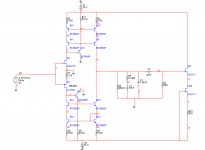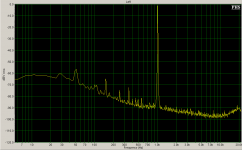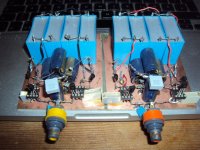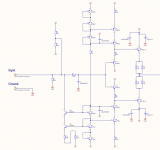This is interesting .....
Website of Wayne Stegall - Distortion Cancelation
The link does not work here.
I tried the AT95E once on an ancient Dual 1219, and it sounded like crap. Perhaps due to the light tonearm, but any cheap shure, ortofon, and even a DL103 (a gross mis-match) sounded markly better.
Rüdiger
Yesterday I managed to sort my 2sj74/2sk170 pairs and try it out in starless. So basically it is almost Joachim’s naked truth circuit, just without extra led referenced cascode. I knew there would be improvement, but what I’ve heard was wow…  I would say it’s day and night difference without much exaggeration. Improvement in all respects, deeper sound stage, better instrument allocation, well you name it. I just couldn’t stop going through my records, it’s was that kind of addictive! Both mirrors are working now, and all details is just at another level, in fact, it is almost too much transparency, as I think I hit my tt and cart limitation. I didn’t notice it before, but now I can clearly hear some imperfections. One thing that started bother me is “s” letter problem. I thought it was clear before, and now I can clearly hear that it’s more “shhh” then “s”. So a quick question to people with more vinyl knowledge then me – is it sibilance from miss tracking ? Cart is new and I thought I aligned it quite good, seems nod good enough.
I would say it’s day and night difference without much exaggeration. Improvement in all respects, deeper sound stage, better instrument allocation, well you name it. I just couldn’t stop going through my records, it’s was that kind of addictive! Both mirrors are working now, and all details is just at another level, in fact, it is almost too much transparency, as I think I hit my tt and cart limitation. I didn’t notice it before, but now I can clearly hear some imperfections. One thing that started bother me is “s” letter problem. I thought it was clear before, and now I can clearly hear that it’s more “shhh” then “s”. So a quick question to people with more vinyl knowledge then me – is it sibilance from miss tracking ? Cart is new and I thought I aligned it quite good, seems nod good enough.
Rüdiger, Thorenz and Dual both had problems with loose bearings in the late 70th, early 80th. After i fixed that they sounded much better. In the REGA arm the AT95E works.
Sampler, this is good news. To help you, try to raise the down pressure a bit and lower the arm a bit. Also i need the circuit diagram. Anyway, i am happy that the sound improved so much.
Sampler, this is good news. To help you, try to raise the down pressure a bit and lower the arm a bit. Also i need the circuit diagram. Anyway, i am happy that the sound improved so much.
Here is the circuit that I'm running currently. RIAA shunt resistor maybe off, as I adjusted it on the fly for best compliance when measuring frq. response. My TT is humble JVC JL-A40 that I pickud up in Frankfurt flohmarkt couple years ago. It was rebuild and tuned by me, and I was quite happy with it, having DL103 on Sumiko HS-12 headshell, that is until good phono stage came up  I will play with pressure and arm height and see were it gets me.
I will play with pressure and arm height and see were it gets me.
Attachments
There is a connection missing between base of Q18 and emitter of Q5 but i assume that the connection is there in the real circuit.Other then that i build that circuit about 1,5 years ago and yes, it sounds very good. I see you have implemented the distortion cancelation trick by using a resistor in the 2SJ74 source.
Yes, missing connection, again I'm multitasking here heavily... I adjusted source resistor for 0V with gates grounded, don't know if it does much, but there was no distortion down to -100dB. Fet's are BL grade but current is a little on the low side (7.2mA). I will post some noise and thd measurements latter.
True... true.... I think mods wouldn't be mad if you didn't left spaces between some words as it is such a big issue. Prices ramps up almost every day for what is left and marked is full of fakes. I just have my fingers crossed for linear releasing complementary for lsk170. Shame on toshiba for loosing interest in what was really not a niche market.
A friend of mine is vice president of Toshiba Germany. I asked him why they do not produce discrete semiconductors any more. He told me that Siemens or Beko buy transistors in the millions and then the price got down to less then a cent per unit. They simply could not make a profit any more and already 25% of the employes had to go in early retirement, so this was a really hard and unpopular decission, also inside Toshiba. He personally was very sorry because he is also a High End freak.
Sad story... well it's just the way this big old world turns 'round these days I guess. Here's spectrum with complementary pair. Averaging set to 100 with peak hold. I know it says nothing on how it sounds, but at least noise is were it should be. There is some hiss left with 26dB amp and 89dB speakers on max volume, but I could put my head in a speaker box on normal listening level and there would be nothing. 50Hz and harmonics gets picked by my bench supply leads, with batteries there is none.
Attachments
Now, that we have such fine phono amp designers helping me i have more time for fundamental research. If you have followed my thread you know my obsession with buffers. I use them almost everywhere, behind the RIAA, behind my CD player, etc.
I found surprising gains in sound even after already good analog stages. I recently had a real enlightenment when i put my latest buffer behind my Forsell CD player that has quite an elaborate analog stage build in already. What struck me with the Forsell over the years is a sound that is totally free of fatigue but also is rather warm sounding. This is the total opposite what you normally experience from CD. Clean and dynamic, yes, full bodied, liquid and musical, no. Usually i switch off after less then an hour. The new buffer behind the Forsell injects excitement and air but still retains the low fatigue effect. Strange, it sounds more open, free and much more transparent but also big, bold and extremely spacious with incredible focus. The soundstage expands now from close before my ears to 5 meters up, 20 meters deep and as wide as the program allows. It is simply so much there there. The buffer is based on the diamond principle that has some advantages. It can be DC coupled without servo, it has low early effect and the miller capacitance is not amplified by voltage gain, so it is as high speed what the transistor specs allow. But it also has problems. Namely modulation of Ube and that modulates Gm because there is a straight relationship between the Ube and collector current. If you hold Ube still by modulating the base you end up with a very linear amplifier. This is more or less the translinear concept. I will show now the evolution of my buffer but the final version is not done yet so this is a work in progress. First i put in a driven, cross coupled cascode over the input trannis. They supply the input transistors with a copy of the signal that drives the output transistors. That gave an amasing improvement in sound all by itself. The second idea is to drive the output transitors from the current mirror, effectively dynamically cascoding them. The third idea is to drive the driven cascodes also from the mirror, this time the right side so that currents balance in the mirror again. This has not being tried out so this is rather hypothetical. The ultimate in entanglement is then to drive the mirror with a copy of the input signal. See Per Anders Super Buffer.
I found surprising gains in sound even after already good analog stages. I recently had a real enlightenment when i put my latest buffer behind my Forsell CD player that has quite an elaborate analog stage build in already. What struck me with the Forsell over the years is a sound that is totally free of fatigue but also is rather warm sounding. This is the total opposite what you normally experience from CD. Clean and dynamic, yes, full bodied, liquid and musical, no. Usually i switch off after less then an hour. The new buffer behind the Forsell injects excitement and air but still retains the low fatigue effect. Strange, it sounds more open, free and much more transparent but also big, bold and extremely spacious with incredible focus. The soundstage expands now from close before my ears to 5 meters up, 20 meters deep and as wide as the program allows. It is simply so much there there. The buffer is based on the diamond principle that has some advantages. It can be DC coupled without servo, it has low early effect and the miller capacitance is not amplified by voltage gain, so it is as high speed what the transistor specs allow. But it also has problems. Namely modulation of Ube and that modulates Gm because there is a straight relationship between the Ube and collector current. If you hold Ube still by modulating the base you end up with a very linear amplifier. This is more or less the translinear concept. I will show now the evolution of my buffer but the final version is not done yet so this is a work in progress. First i put in a driven, cross coupled cascode over the input trannis. They supply the input transistors with a copy of the signal that drives the output transistors. That gave an amasing improvement in sound all by itself. The second idea is to drive the output transitors from the current mirror, effectively dynamically cascoding them. The third idea is to drive the driven cascodes also from the mirror, this time the right side so that currents balance in the mirror again. This has not being tried out so this is rather hypothetical. The ultimate in entanglement is then to drive the mirror with a copy of the input signal. See Per Anders Super Buffer.



